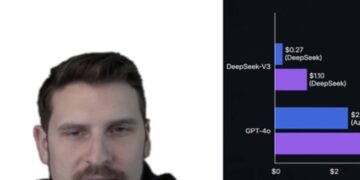- General Information
- Health
- Society
- Media
- Become a MemberPREMIUM
- Events
- Contact Us
- Shop
- Categories
- Access to Health
- Ageing & Longevity
- Asset-Based Community Development
- Community & Health
- Ecology & Environment
- Economic & Political Root Causes
- Economic Stability
- Education
- Environmental Contaminants
- Ethnicity & Gender
- Health Condition of the Body
- Holistic Approach
- Law & Human Rights
- Men’s Health
- Natural Medicine
- Nutrition & Food
- On A Philosophical & Ethical Note
- Political Acceptance & Opposition
- Race
- Social Determinants of Health
- Traditional Medicine & Adjuvant Therapies
- Transhumanism
- Wellness
- Women’s Health
BATSHIT CRAZY: HOW THE US ECONOMY SURVIVES BY AI AND BIG TECH
A New Bubble in the Making?
Are the monstrous amounts being invested in the AI sector realistic and sustainable? And more importantly… will these unprecedented investments ever deliver the expected returns?
The S&P 500 is the stock index that includes the 500 largest publicly listed companies on the New York Stock Exchange. It is therefore by far the most important market barometer. This single index represents roughly 80% of the total market capitalization of the entire U.S. stock market (NYSE and NASDAQ combined). And it has to be said: this indicator has been glowing bright green for quite some time. In contrast to many other stock exchanges where red has now become the traditional background color.
But is that actually true? Are those 500 American stocks really worth that much? Are those companies really making that much profit, and are the stock prices justified by real earnings or realistic earnings expectations? That is what this publication is about.
The Magnificent 7 versus the S&P 493
How representative is the S&P 500 index of all 500 stocks in that basket? And how representative is this one basket of the real business climate – not on Wall Street, but in the American heartland?
The reality is that the S&P 500 is being propped up by the “Magnificent 7”¹ – the seven high-flying superstar stocks that just keep rising. Because yes, anyone who bought shares years ago in Meta (Facebook), Alphabet (Google), Amazon, Microsoft, Tesla, Nvidia, or Apple made a very good deal.
The flip side of this euphoria is that 80% of all the other stocks in the same S&P 500 have declined. In short, the S&P 500 is in reality being held aloft by those 7 magical stocks. Remove those 7 success stories from the index and you get a completely different picture. Then you see that the price gain for those remaining 493 stocks over the past stock-market year was barely 7%. Worse still, 80% of those other 493 stocks are trading lower than they were a year ago.
And while 7% may seem like a healthy return, remember that in the same period the dollar lost 10.7% of its value against other currencies². Adjusted for inflation and dollar depreciation, those 493 other stocks therefore show not a profit, but a real loss.
The Magnificent 7 versus the broader economy
That 7% is also significantly lower than the actual inflation rate, which is estimated at around 10%. The Bureau of Labor Statistics³ (BLS) may publish an inflation figure of 3.1%, but essential items such as housing, used goods, tuition fees, beef, medical procedures, payroll taxes, or childcare are missing from that basket. But that’s not really relevant, because Americans obviously don’t eat beef, don’t live in houses, are in perfect health, and don’t have children.
The effects of the Trump tariffs have not yet been felt on Wall Street. But the spending pattern of the average American family, on the other hand, has changed dramatically. Used-car dealers are seeing their sales collapse and are going bankrupt. Fast-food chains are also a good indicator. Wendy’s⁴ is planning to close an estimated 300 locations, Jack in the Box is closing 200 restaurants, Starbucks is closing 185 outlets, and both Burger King and McDonald’s are planning drastic measures. Shoe manufacturer Nike⁵ is having increasing difficulty keeping its relatively expensive athletic shoes within the family budget of the average American and is now looking at which additional employees can be laid off. The two major U.S. internet providers are also laying off staff – each in their own way. AT&T is doing so steadily month after month, while Verizon is letting go of 15,000 people in one go. Two more parameters: both household private debt levels and mortgage delinquency rates continue to rise.
Then the question arises: “Are these the people and consumers who will soon start paying an extra $35 a month to use LLMs or AI services on top of an ever-tighter family budget?” Is this the market on which the valuations of Palantir, Nvidia, OpenAI, or Oracle are based? Clearly not.
The primus of the class versus the Magnificent 7
The absolute crown jewel of the S&P 500 – and by extension the entire Mag7 – is Palantir. Over the past few years, the stock has risen from $7 to $200. It currently trades at a P/E⁶ of well over 520. In other words, Palantir investors are paying $520 for every dollar of profit the company makes today. These are extremely high multiples, meaning the share price rests on exuberant growth expectations. This implies that if growth slows from “exuberant” to merely “very good,” the current valuation will come under severe pressure. The company is making huge profits, yes, in a growth market, but even so, those earnings expectations appear overvalued and unsustainable in the medium term.
Michael Burry has once again done the unthinkable, just as he did in 2008. The man has closed his Scion Asset Management fund and wants to return the invested capital – plus large profits – to his investors. How? By shorting Palantir. Exactly.
He is convinced that companies like Oracle, OpenAI, Nvidia, and Palantir are dramatically overvalued and are heading for a massive correction. When Palantir CEO Alex Karp⁷ is asked to respond to Michael Burry’s short position, he reacts evasively, irritably, and dismissively, correctly pointing out that AI is the engine behind the S&P 500 and, by extension, the entire U.S. equity market. Anyone who calmly considers this argument will feel that it can just as easily be read as a devastating counter-argument.
Ask yourself: what revenue figures would justify the return on the enormous AI investments over the next five years? For a 10% return, the global AI ecosystem would need to generate roughly $650 billion in annual revenue. An ecosystem that invests hundreds of billions quarter after quarter in servers, GPUs, and computing power while currently showing only a tiny revenue stream. And no one knows how or when these companies will ever become profitable.
Round-tripping
In the capital markets where Nvidia, Microsoft, Amazon, OpenAI, and Oracle are currently pouring in unprecedented billions, some remarkable things are happening. It increasingly appears that several hyperscalers are engaging in forms of round-tripping.
Round-tripping occurs when a company sells an asset to another company and simultaneously agrees to buy back the same or a comparable asset at roughly the same price. Such a swap delivers no real economic value but can be presented in the accounts as a profitable sale or purchase. This makes the company appear larger than it actually is, while the transaction generates no genuine profit.
The tens of billions these “hyperscalers” are investing are merely a foretaste of the investment path that will involve hundreds and even thousands of billions of dollars in the coming years – commitments these tech companies have already made. These are investments in computing power, GPUs, data centers, and electricity generation.
Two developments should prompt investors to exercise caution and vigilance.
Depreciation periods
Nvidia sells GPUs and hardware for fortunes to customers like Oracle, Meta, or OpenAI, giving its own stock price a strong upward push – and rightly so, because Nvidia makes the world’s most powerful and energy-efficient computing hardware. But when we look at Nvidia’s customers, that’s where the problem lies. These companies depreciate the hardware over much longer periods than the 2 to 3 years within which that computing hardware will inevitably become obsolete.
In the books of the hyperscalers, we see capital expenditures⁸ for GPUs and computing power being depreciated over 5 years. As a result, these same hyperscalers are already creating a revenue-side shortfall estimated at $176 billion by 2026 (some by 2027, others by 2028). And no one can see how Oracle, Amazon, OpenAI, Meta, and Alphabet will close that gap when the time comes.
When we look at the investments still planned, the revenue-side deficits will only grow larger.
Cross-pollination or cannibalism?
The tens of billions that a company like OpenAI invests every quarter in GPUs and server rooms do not appear in the P&L. Where do they show up? In its own cash flow statement, for example. But also elsewhere – in Microsoft’s accounts, for instance, where those same billions disappear among the enormous profits Microsoft books.
Because yes, Microsoft owns 32.5% of OpenAI and buys the Nvidia hardware that it then leases to OpenAI. This camouflages investments being made in a sector that still generates no profits. OpenAI is by no means an exception. The entire Mag7 is expanding its server farms.
Microsoft invested $31 billion last quarter in GPUs and server rooms, while its own revenue was $27 billion.
Amazon invested $35 billion in Q3 – twice its profit in the same quarter.
Google invested more than $65 billion in Q3 – two-thirds of its booked profits.
Facebook invested $18 billion – significantly more than its Q3 profit.
Every tech company in the AI sector exhibits the same investment frenzy, burning through historic cash reserves to secure a strategic position in what is still (rightly) seen as the industry of the future. And while the absolute amounts are enormous, what really deserves attention is how sharply these amounts have risen in recent months. It becomes truly eye-opening when we review the planned investments for the coming quarters and years. The pace is so frantic that analysts are now questioning the billion-dollar deals taking place in the sector. OpenAI is involved in almost every major deal and signs monster contracts despite having hardly any cash of its own. How is that possible?
Well, when OpenAI sells a stake in itself to Microsoft, it uses the proceeds to buy hardware from Nvidia. Anthropic and Amazon finance their growth in the same way. Even a spin-off like xAI leans on Tesla for its investments. What do xAI, Anthropic, and OpenAI have in common? They buy enormous volumes of Nvidia computing hardware for which they lack the financial resources. These companies have virtually no revenue and make no profit at all. So how do they finance those purchases? Easy…
Nvidia, in turn, invests $100 billion in OpenAI⁹. The fact that Nvidia does not have the cash or liquidity for such a stake is no problem, because in return OpenAI commits to purchasing $200 billion worth of Nvidia equipment – a contract that serves as collateral for Nvidia’s participation in OpenAI¹⁰.
Oracle joins the musical chairs as well. OpenAI signed a $300 billion contract with Oracle for the rental of server and data-center capacity¹¹. Oracle in turn spends that same $300 billion on computing hardware it promises to buy from Nvidia. Nvidia then uses the proceeds from sales to Oracle for further investments in OpenAI.
OpenAI doesn’t only buy hardware from Nvidia. AMD also builds excellent hardware. That’s why OpenAI signed a $100 billion contract with AMD¹² in exchange for equity. Naturally, OpenAI does not have the liquidity for the planned $100 billion in AMD hardware. So AMD sells 10% of its own shares to OpenAI. With those AMD shares as collateral, OpenAI can raise multiples of that amount on the financial markets to fund the investments that are supposed to make the company profitable in the long run.
CoreWeave is another remarkable player in this recent AI universe. On May 16, 2025, CoreWeave announced a $4 billion contract with OpenAI¹³ – an expansion of a previous $11.9 billion deal. On September 15, 2025, CoreWeave announced a strategic agreement with Nvidia, which is both supplier and investor¹⁴. The Q3 results CoreWeave published on November 10 were striking: a relatively small player actually making a profit. The euphoria was short-lived. A day later it was reported that delays in data-center construction sharply cut the profit outlook¹⁵. The stock closed 10% lower that day.
These companies are not engaging in classic round-tripping. It would be intellectually dishonest to claim that. But the financing method by which they are locking themselves to one another should inspire caution, because the monstrous contract values to which they have committed for the coming years have led to an escalating valuation and stock price. And no one knows how or when these companies will ever turn a profit. No one knows whether suppliers like Nvidia, Intel, Cisco, or AMD will retain access to exotic materials and components from China. No one knows where the electricity will come from for the exponential growth in computing power and cooling capacity of all those additional data centers.
This bubble is very different from the internet bubble of 1997–2000. Unlike 25 years ago, today’s AI companies are accumulating real knowledge, intellectual property, and pioneer status. Small growth companies are locking themselves onto large listed players that are monitored by the SEC. That was different back then.
This manic growth strategy and logic is, in a way, understandable. This growth spurt is a race against the clock in which as much computing power as possible must be gathered to train and improve their own Large Language Models faster than anyone else. Only in this way can a single player capture an absolute and dominant market position. Google is the best and most recent example of that logic: winner takes all.
REFERENCES:
| CNBC Magnificent 7 Index.MAG7:Exchange https://www.cnbc.com/quotes/.MAG7 2 Where is the U.S. dollar headed in 2025? -JPMorgan 3 Bureau of Labor Statistics 4 WEN • NASDAQ Wendy’s Company 5 Nike IncNKE:NYSE 6 De P/E-ratio (price-to-earnings) vergelijkt de aandelenprijs met de winst per aandeel. Ze toont hoeveel beleggers betalen voor één euro winst. 7 Alex Karp on ‘Big Short’ investor Michael Burry: ‘Bats— crazy’ for bets against Palantir 8 CAPEX ofwel Capital Expenditures zijn kapitaaluitgaven die een bedrijf besteedt aan investeringen met een afschrijvingstermijn langer dan één jaar. 9 https://www.nytimes.com/2025/09/22/technology/nvidia-openai-100-billion-investment.html 10 OpenAI and NVIDIA Announce Strategic Partnership to Deploy 10 Gigawatts of NVIDIA Systems 11 Analyst Says Oracle (ORCL) Deal With OpenAI is ‘Very Risky’ – ‘Not a Customer That Can Pay Their Obligations’ 12 OpenAI en chipmaker AMD sluiten miljardendeal 13 OpenAI signs new $4bn cloud deal with CoreWeave 14 CoreWeave’s stock rallies on disclosure of $6.3 billion order from Nvidia 15 Nvidia-backed CoreWeave’s shares fall as data center delay hits annual revenue forecast |
Disclaimer
The views and analysis expressed in this content (video, blog, article, etc.) are solely that of the author and does not necessarily reflect the views of humani-well, the organisation, or other associated parties.
Medical disclaimer: you should not rely on the information on this website as a replacement for seeing a doctor or other qualified healthcare provider for a diagnosis or treatment. Nothing in this publication should be interpreted as a substitute for the advice of a qualified healthcare provider. Please consult a medical professional before using any information contained in this publication.
Joachim Van Wing
A sharp pen, combined with extensive knowledge and deep insights is what you can expect from Joachim. As a sholar, he studied the global economy related to oil for over two decades. His projections on short- and long-term effects of the interplay between economics and politics are often flabbergasting. As an acclompished businessman in petro-derivates, he has a vast network of high placed peers which helps him to keep track of international monetary and energy evolutions.
© 2025 Humaniwell | CHOOSE WISELY. Powered by NoCodeLabs.


























